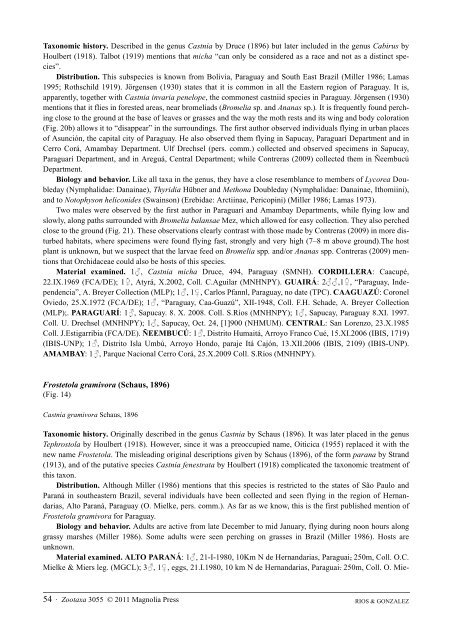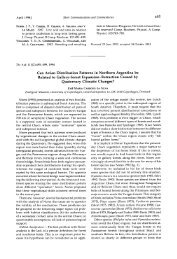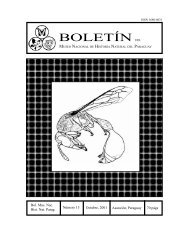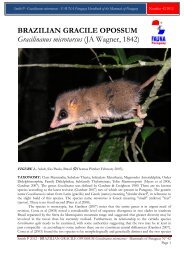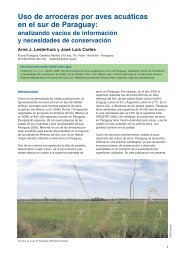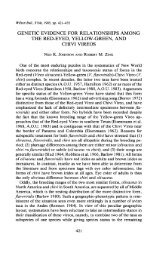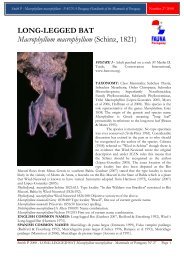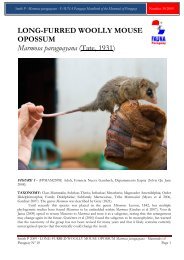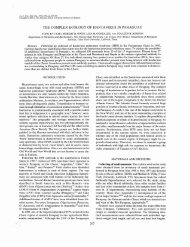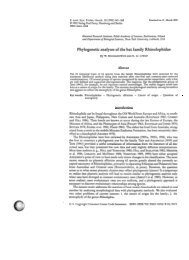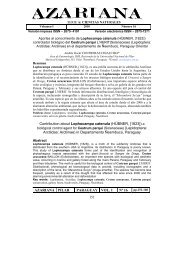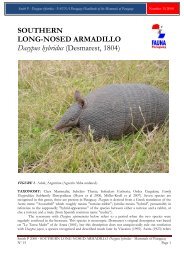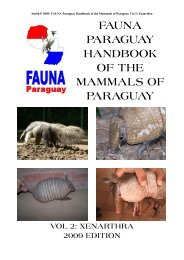A synopsis of the Castniidae (Lepidoptera) of ... - FAUNA Paraguay
A synopsis of the Castniidae (Lepidoptera) of ... - FAUNA Paraguay
A synopsis of the Castniidae (Lepidoptera) of ... - FAUNA Paraguay
Create successful ePaper yourself
Turn your PDF publications into a flip-book with our unique Google optimized e-Paper software.
Taxonomic history. Described in <strong>the</strong> genus Castnia by Druce (1896) but later included in <strong>the</strong> genus Cabirus by<br />
Houlbert (1918). Talbot (1919) mentions that micha “can only be considered as a race and not as a distinct species”.<br />
Distribution. This subspecies is known from Bolivia, <strong>Paraguay</strong> and South East Brazil (Miller 1986; Lamas<br />
1995; Rothschild 1919). Jörgensen (1930) states that it is common in all <strong>the</strong> Eastern region <strong>of</strong> <strong>Paraguay</strong>. It is,<br />
apparently, toge<strong>the</strong>r with Castnia invaria penelope, <strong>the</strong> commonest castniid species in <strong>Paraguay</strong>. Jörgensen (1930)<br />
mentions that it flies in forested areas, near bromeliads (Bromelia sp. and Ananas sp.). It is frequently found perching<br />
close to <strong>the</strong> ground at <strong>the</strong> base <strong>of</strong> leaves or grasses and <strong>the</strong> way <strong>the</strong> moth rests and its wing and body coloration<br />
(Fig. 20b) allows it to “disappear” in <strong>the</strong> surroundings. The first author observed individuals flying in urban places<br />
<strong>of</strong> Asunción, <strong>the</strong> capital city <strong>of</strong> <strong>Paraguay</strong>. He also observed <strong>the</strong>m flying in Sapucay, Paraguarí Department and in<br />
Cerro Corá, Amambay Department. Ulf Drechsel (pers. comm.) collected and observed specimens in Sapucay,<br />
Paraguarí Department, and in Areguá, Central Department; while Contreras (2009) collected <strong>the</strong>m in Ñeembucú<br />
Department.<br />
Biology and behavior. Like all taxa in <strong>the</strong> genus, <strong>the</strong>y have a close resemblance to members <strong>of</strong> Lycorea Doubleday<br />
(Nymphalidae: Danainae), Thyridia Hübner and Methona Doubleday (Nymphalidae: Danainae, Ithomiini),<br />
and to Notophyson heliconides (Swainson) (Erebidae: Arctiinae, Pericopini) (Miller 1986; Lamas 1973).<br />
Two males were observed by <strong>the</strong> first author in Paraguarí and Amambay Departments, while flying low and<br />
slowly, along paths surrounded with Bromelia balansae Mez, which allowed for easy collection. They also perched<br />
close to <strong>the</strong> ground (Fig. 21). These observations clearly contrast with those made by Contreras (2009) in more disturbed<br />
habitats, where specimens were found flying fast, strongly and very high (7–8 m above ground).The host<br />
plant is unknown, but we suspect that <strong>the</strong> larvae feed on Bromelia spp. and/or Ananas spp. Contreras (2009) mentions<br />
that Orchidaceae could also be hosts <strong>of</strong> this species.<br />
Material examined. 1♂, Castnia micha Druce, 494, <strong>Paraguay</strong> (SMNH). CORDILLERA: Caacupé,<br />
22.IX.1969 (FCA/DE); 1♀, Atyrá, X.2002, Coll. C.Aguilar (MNHNPY). GUAIRÁ: 2♂♂,1♀, “<strong>Paraguay</strong>, Independencia”,<br />
A. Breyer Collection (MLP); 1♂, 1♀, Carlos Pfannl, <strong>Paraguay</strong>, no date (TPC). CAAGUAZÚ: Coronel<br />
Oviedo, 25.X.1972 (FCA/DE); 1♂, “<strong>Paraguay</strong>, Caa-Guazú”, XII-1948, Coll. F.H. Schade, A. Breyer Collection<br />
(MLP);. PARAGUARÍ: 1♂, Sapucay. 8. X. 2008. Coll. S.Ríos (MNHNPY); 1♂, Sapucay, <strong>Paraguay</strong> 8.XI. 1997.<br />
Coll. U. Drechsel (MNHNPY); 1♂, Sapucay, Oct. 24, [1]900 (NHMUM). CENTRAL: San Lorenzo, 23.X.1985<br />
Coll. J.Estigarribia (FCA/DE). ÑEEMBUCÚ: 1♂, Distrito Humaitá, Arroyo Franco Cué, 15.XI.2006 (IBIS, 1719)<br />
(IBIS-UNP); 1♂, Distrito Isla Umbú, Arroyo Hondo, paraje Itá Cajón, 13.XII.2006 (IBIS, 2109) (IBIS-UNP).<br />
AMAMBAY: 1♂, Parque Nacional Cerro Corá, 25.X.2009 Coll. S.Ríos (MNHNPY).<br />
Frostetola gramivora (Schaus, 1896)<br />
(Fig. 14)<br />
Castnia gramivora Schaus, 1896<br />
Taxonomic history. Originally described in <strong>the</strong> genus Castnia by Schaus (1896). It was later placed in <strong>the</strong> genus<br />
Tephrostola by Houlbert (1918). However, since it was a preoccupied name, Oiticica (1955) replaced it with <strong>the</strong><br />
new name Frostetola. The misleading original descriptions given by Schaus (1896), <strong>of</strong> <strong>the</strong> form parana by Strand<br />
(1913), and <strong>of</strong> <strong>the</strong> putative species Castnia fenestrata by Houlbert (1918) complicated <strong>the</strong> taxonomic treatment <strong>of</strong><br />
this taxon.<br />
Distribution. Although Miller (1986) mentions that this species is restricted to <strong>the</strong> states <strong>of</strong> São Paulo and<br />
Paraná in sou<strong>the</strong>astern Brazil, several individuals have been collected and seen flying in <strong>the</strong> region <strong>of</strong> Hernandarias,<br />
Alto Paraná, <strong>Paraguay</strong> (O. Mielke, pers. comm.). As far as we know, this is <strong>the</strong> first published mention <strong>of</strong><br />
Frostetola gramivora for <strong>Paraguay</strong>.<br />
Biology and behavior. Adults are active from late December to mid January, flying during noon hours along<br />
grassy marshes (Miller 1986). Some adults were seen perching on grasses in Brazil (Miller 1986). Hosts are<br />
unknown.<br />
Material examined. ALTO PARANÁ: 1♂, 21-I-1980, 10Km N de Hernandarias, Paraguai, 250m, Coll. O.C.<br />
Mielke & Miers leg. (MGCL); 3♂, 1♀, eggs, 21.I.1980, 10 km N de Hernandarias, Paraguai. 250m, Coll. O. Mie-<br />
54 · Zootaxa 3055 © 2011 Magnolia Press<br />
RIOS & GONZALEZ


